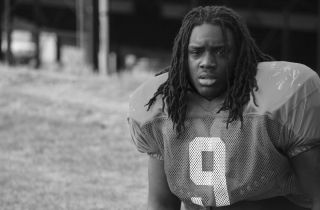By ANDRE MACK-ROBINSON – Variety Writer
Clarke Central High School freshman defensive lineman Z’Javion Russel is among the many CCHS students who embrace the dreadlock hair style on the football field. “It’s just a way to express myself and my individuality,” Russel said.
Lil Wayne, Zack de la Rocha and Whoopi Goldberg are among the many notable figures who presently sport dreadlocks, a style also seen in Clarke Central High School’s hallways.
“It’s a trend. It’s different. It gives you a chance to express your different individuality. You don’t have to do the classic thing or what everybody else is doing,” CCHS Curriculum Assistance Program for Students department teacher Je’nean Knight said.
Suzette Francis is known as a natural lifestyle practitioner and operates a home-based hair salon in Charlotte, N.C. that specializes in natural hair styles. She does not use chemicals in her hair and only eats organic foods. According to Francis, dreadlocks originated from people of African descent living in the islands of the West Indies. The inhabitants of these islands, of which include Jamaica, allow their hair to grow naturally.
“Letting their hair grow and take on its natural course — locking up, napping up — that was what we call or refer to as dreaded looks style on the football field. “It’s just a way to express myself and my individuality,”Russell said. ‘dreadlocks’,” Francis said. “Europeans looked at them like, ‘Oh, how dreadful’ because they were unattractive.”
Francis believes dreadlocks have been prominent in West Indian culture because they often signify a stand against the dominant culture, which took place in the West Indies through a movement called Rastafarianism.
“Locks (are) rebellious (in) nature because there were a lot specialists from (Europe) coming in and telling people how they should be and what was beautiful in terms of being Caucasian and having long, straight hair,” Francis said. “Rastafarians took on that culture and lifestyle (of ) stepping against the grain and saying, ‘No.’”
According to Encyclopedia Britannica Online, Rastafarianism is a “religious and political movement begun in Jamaica in the 1930s and adopted by many groups around the globe that combines Protestant Christianity, mysticism, and a pan-African political consciousness.”
For Francis, an active Rastafarian, the movement is more of a way of life than faith-based practice.
“Rastafarianism is a lifestyle more so than a religion; it’s a lifestyle of being natural and pulling back, as far as hair, original roots and discussing and loving the cultural, that lifestyle,” Francis said.
In the early 1970s, elements of Rastafarian culture, including reggae music, came to the European and American marketplace, according to Paul Jones, a collector of reggae music for more than two decades. Dreadlocked artists such as Bob Marley and Peter Tosh touted their faith and, on a few tracks, their affinity for marijuana use.
“Bob Marley doesn’t exactly always advocate the use of (marijuana) directly. Like many modern hip hop artists, he would often reference the use of cannabis while not politicizing the issue directly. Notable songs which contain references or celebrations to Cannabis use are ‘Kaya,’ ‘Turn Me Loose’ and ‘Chant Down Babylon,’” Jones said. “Peter Tosh was more outspoken regarding his beliefs on the subject. His song ‘Legalize It’ is often referenced as the most direct political message a Reggae artist made regarding Cannabis use.”
Jones has also noticed the negative connections between Rastafarian culture, Reggae music and marijuana use.
“This is a bit of a loaded statement, but I believe the majority of the general population associates dreadlocks with Cannabis use,” Jones said. “Dreadlocks are an element of the culture, just as cannabis use is, but they are in no way mutually-exclusive.”
Francis is one of those with dreadlocks who has felt the effects of the negative stereotypes.
“It’s definitely a stereotype — people (are) going to tie in that, if you have locks, then you are a Rasta and you smoke marijuana,” Francis said. “That’s not the case because, as we know, locks have become a big fashion trend, as opposed to a lifestyle, for many.”
CCHS junior Aerick McGee, who has worn his hair in dreadlocks since his freshman year, of high school enjoys the style of his hair, but not the stereotypes he has faced from those who do not understand the fashion.
“Bob Marley had dreads. Since he often smoked weed, they assume (we are) underachievers and potheads,” McGee said.
Another typical stereotype faced by those who wear dreadlocks is that they are unclean. However, many people who sport dreadlocks claim that it is important to clean and wash your locks in order to to keep them appealing.
“I treat my hair personally; I do what they call a ‘dry shampoo.’ I try to get it retwisted and washed about once a month to keep (my dreadlocks) looking attractive,” Knight said.
Some like Francis wear the hairstyle but dislike the word “dreadlocks” and refer to them as “locks.” They feel their hair is attractive and that beauty is based upon personal opinion.
“Locks represent us taking on our own beauty, as opposed to being told that we had to fit into a certain mold or even hold onto that belief that your hair has to be straightened in order to be pretty,” Francis said. “My hair is beautiful and it’s just as good as anybody else’s.”
